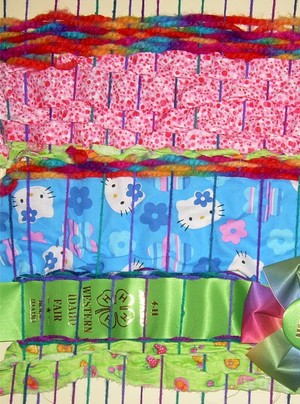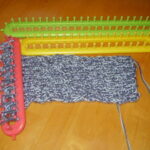One of my favorite kid friendly summer crafts, is free form weaving which can be done without any special equipment. All you need is a door, a bunch of thrift store yarn, and arm loads of scrap fabric. How easy is that?
Weaving is a method of making textiles out of two sets of thread or yarn. The “warp” threads run up and down, and the “weft” runs side to side. Woven fabrics are traditionally made on a loom, but for this project, an unique wall hanging can be made on something as simple as a cabinet door.
Supplies
Before you start, you will need a few supplies. You can start by digging around your own craft box for an assortment of yarns and fabric remnants. Look for interesting ribbons, both cloth and paper. Odds and ends of yard twine are also nice, and perhaps some chunky beads or buttons.
If you don’t have a large supply of these items, visit a local thrift store or fabric store. The fabric you purchase must be at least 24 inches wide, though a standard 44 inches width is preferable. And while regular yarn is fine, extra thick craft or rug yarn is more appealing for young children.
You will also need a roll of heavy tape and scissors. An optional item is the shuttle, which can be found at all yarn & fabric stores. A shuttle is like a long, slender spool which holds the wrapped yarn. The advantage of using a shuttle is that it keeps the yarn and fabric contained, during the weaving process.
You might also want a piece of dowel, driftwood, or some other frame from which to hang the finished weaving.
How to set up
Begin by taping one end of the yarn at the top of a door. Pull the string forward and down the front of the door, underneath the door and up the back. Continuing wrapping the door until you reach the desired width (picture #2). Cut the end of the yarn, where it meets up with the top of the door again. Secure this loose end with another piece of tape. Older children and adults can manage a tighter pattern of 10-12 threads per inch. For smaller children though, space the threads about 2-4 threads per inch. This looser weave is easier for tiny fingers.
How to weave
The first step is to cut the fabric pieces into one or two inch strips.
Beginning with either the yarn or a fabric strip, tie a small knot on the end warp thread, about 12″ down from the top of the door. Moving from left to right, the child should feed the shuttle under and over the warp threads, in an alternating pattern (picture 3#). When the end is reached, the yarn is pulled around the last warp thread and head back in the opposite direction.
Using either hands or shuttle, continue to weave the material under and over the warp threads, moving from one direction to the other (picture #4). As your child weaves, she should push the yarn or strips of fabric into place with her fingers, to tighten the weave (picture #5). When she is ready to change fabrics or yarns, simply tie one end to the next. Don’t worry about hiding the knots, this only adds to the charm!
One advantage to working on a door, is that two children can weave at the same time. While one child is weaving on the front side of the door, the second child could be weaving on the reverse side.
Finish it off
Once the wall hanging has reached the desired length, it can be removed from the door. This is done by cutting the warp strings loose from the door. Start with the bottom, and then cut the top threads. Carefully remove the weaving from the door, and lay down gently on a flat work surface.
The loose warp threads should be tied to create a fringed border to finish the weaving. You can start on either end, and work from left to right. With your fingers, take the first two warp thread ends and tie in a square knot. Continue by tying the next 2 warp threads, and so on, until you have reached the opposite edge. When all the loose thread ends have been tied, trim them to the desired length.





